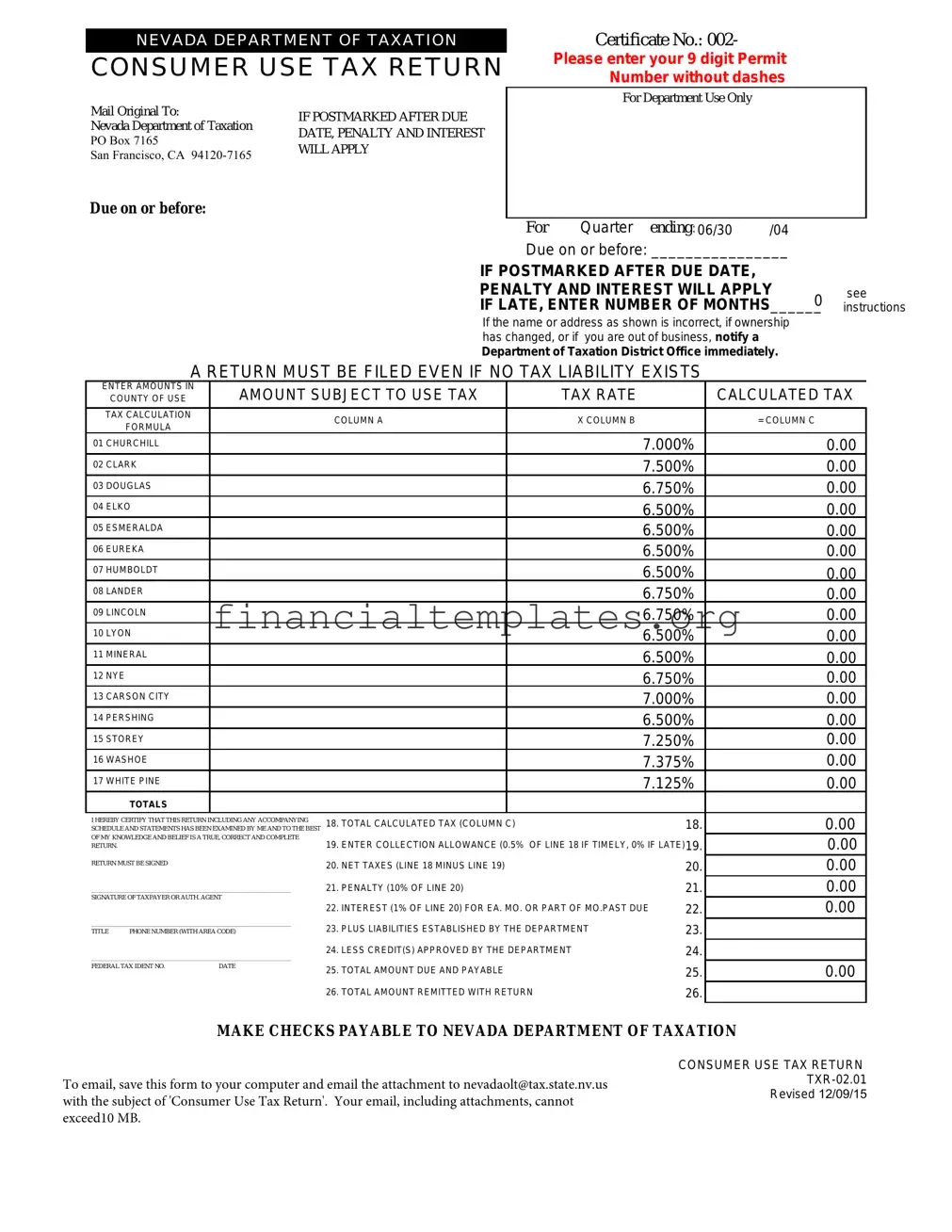The Consumer Use Tax Return form from Nevada shares resemblances with the Sales and Use Tax Return, commonly utilized across various states. Both forms serve the purpose of declaring taxes owed on purchases. Where the Consumer Use Tax Return focuses on items bought without the Nevada sales tax applied, the Sales and Use Tax Return often encompasses broader categories of sales, services, or rentals. They calculate tax owed by applying specific rates to the purchase amounts, adjusting for county-specific tax rates where applicable. Despite different focal points—one on consumer purchases, the other on sales, services, or rentals—both forms ensure tax compliance on transactions not covered at the point of sale.
Similar to the Nevada Consumer Use Tax Return is the Income Tax Return, used by individuals and businesses across the United States. While the Consumer Use Tax Return addresses taxes on tangible personal property purchases, the Income Tax Return calculates tax based on earned income over the year. Both forms require the taxpayer to provide financial details, calculate the amount of tax owed, and account for any applicable deductions or allowances. Dedication to accuracy and timeliness is critical in both instances to avoid penalties and interest for late submissions. Though they cater to different aspects of taxation, each form plays a crucial role in the overarching tax system.
The Business License Renewal forms found in many jurisdictions bear resemblance to the Nevada Consumer Use Tax Return in their administrative purpose. These forms also need to be submitted periodically and often require calculations based on the business's activities, much like determining tax due on purchases. While the Business License Renewal typically calculates fees based on gross receipts, location, or business type, the Consumer Use Tax Return calculates tax based on untaxed purchases. Nonetheless, both types of forms are essential for compliance with local and state requirements, ensuring businesses can legally operate and that tax dues are accurately reported and paid.
Property Tax Declaration forms, required annually by property owners, share commonalities with the Nevada Consumer Use Tax Return through their focus on accurately reporting values subject to tax. Property taxes are based on the assessed value of real and sometimes personal property, whereas the Consumer Use Tax focuses on tangible personal property purchases. Each form requires the taxpayer to list values that determine their tax responsibility. Both are pivotal in the function of local governments, funding public services and infrastructure, underscoring the taxpayer's role in contributing to community resources.
Vehicle Registration forms, necessary for legally operating a vehicle on public roads, also parallel the Nevada Consumer Use Tax Return's function. These forms often require payment of taxes or fees based on vehicle type, value, and intended use—similar to how the use tax is determined by the value of the purchased goods. While one directly funds road maintenance and safety programs, the other compensates for tax not collected at the sale point, ensuring fair taxation across purchasing methods. The emphasis on declaring accurately and paying the appropriate amount is a shared aspect between these documents.
The Employee's Withholding Allowance Certificate, another staple in the tax document arsenal, indirectly relates to the Nevada Consumer Use Tax Return. It helps determine the amount of income tax to withhold from an employee's paycheck, impacting the individual's net income and indirectly their purchasing power. While the Consumer Use Tax Return reconciles untaxed purchases at the consumer level, the withholding certificate functions at the income level, both playing roles in the wider tax compliance landscape. The connection lies in the alignment of individual financial responsibility with state tax laws.
The Excise Tax Return, required for certain products or services that come with an added tax burden, like gasoline, tobacco, or alcohol, shares the goal of tax compliance with the Nevada Consumer Use Tax Return. Despite their focal differences—specific goods or services versus broad-based consumer purchases outside the state's sales tax—the intent to ensure taxes are fully and fairly collected remains the same. Both forms address segments of the tax system that could otherwise be prone to evasion, underscoring the importance of diverse forms in capturing necessary revenues for public services.

